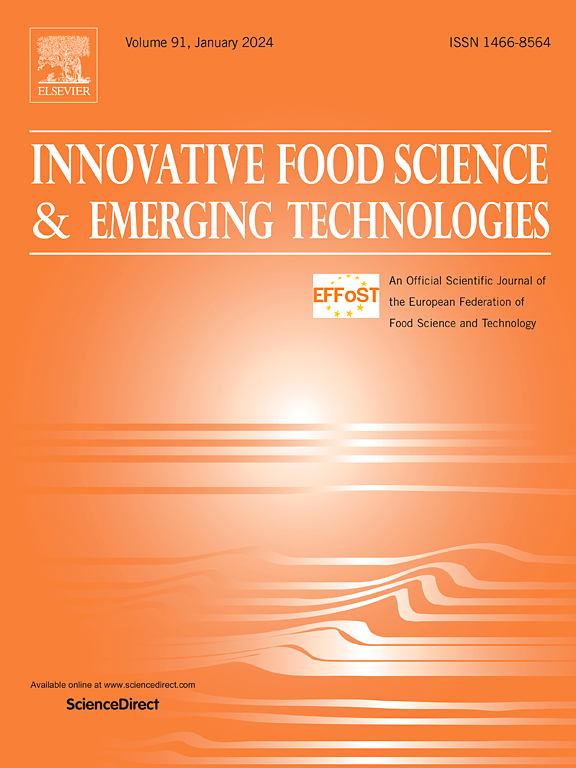菜花叶浓缩蛋白:过滤和稳定溶液对提取和理化性质的影响
IF 6.3
1区 农林科学
Q1 FOOD SCIENCE & TECHNOLOGY
Innovative Food Science & Emerging Technologies
Pub Date : 2025-05-07
DOI:10.1016/j.ifset.2025.104037
引用次数: 0
摘要
本研究旨在通过综合理化分析,探讨花椰菜叶副产物作为可再生蛋白质来源的潜力。目的是评价碱性酸沉淀法在稳定溶液(NaCl、乙二胺四乙酸[EDTA]和焦亚硫酸钠)浓度(5%、10%和15%)下的效果;5%水为对照)和筛滤(124 μm)对菜叶浓缩蛋白(cauc - lpcs)性能和得率的影响。新鲜菜花叶片的水分含量为88.74%。干燥后干叶含水量降至11.26%,粗蛋白质含量为19.81%。稳定溶液浓度和筛滤对菜叶汁的粒径分布有影响。稳定液与筛滤联合作用对LPCs的粒径分布有显著影响。蛋白质质量平衡分析表明,在加工过程中,特别是在筛过滤和离心后,碱性叶汁损失显著。cu - lpcs的含水率为3% ~ 4.5%。颜色分析显示基于稳定溶液和过滤的显着差异,影响消费者的接受度。筛网过滤降低了cauc - lpcs的收率,而稳定液对其收率无显著影响。过滤后的样品蛋白质含量较高(62.44%),在稳定溶液浓度超过5%时观察到平台。Zeta电位分析显示过滤和未过滤样品之间存在差异。蛋白质的溶解度随pH值的增加而增加,筛滤后的样品溶解度较低。热分析表明,变性峰温度范围为60.23 ~ 62.83℃。扫描电镜图像显示结构,多层形貌受加工条件的影响。这些见解有助于理解提取参数如何影响cac - lpc特性,为从未充分利用的绿色生物质中大规模生产工业蛋白质提供了一条有前途的途径。本文章由计算机程序翻译,如有差异,请以英文原文为准。
Leaf protein concentrate from cauliflower leaves: Effect of filtration and stabilizing solution on extraction and physio-chemical properties
This study aimed to investigate the potential of cauliflower leaf-by-product as a renewable protein source through comprehensive physio-chemical analysis. The objectives were to evaluate the effect of alkaline acid precipitation method along with stabilizing solution (NaCl, ethylenediaminetetraacetic acid [EDTA] and sodium metabisulphite) concentrations (5, 10, and 15 %; 5 % water as control) and sieve filtration (124 μm) on the properties and yield of cauliflower leaf protein concentrates (CAU-LPCs). The fresh cauliflower leaves have a moisture content of 88.74 %. After drying the moisture content of dry leaves reduced to 11.26 % and had a crude protein content of 19.81 %. Particle size distribution of cauliflower leaf juice was influenced by stabilizing solution concentration and sieve filtration. The combination of stabilizing solution and sieve filtration significantly influenced particle size distribution of LPCs. Protein mass balance analysis revealed significant losses during processing, particularly after sieve filtration and centrifugation of alkaline leaf juice. Moisture content of CAU-LPCs ranged from 3 to 4.5 %. Colour analysis showed significant differences based on stabilizing solution and filtration, impacting consumer acceptability. Sieve filtration reduced yield of CAU-LPCs, while stabilizing solution had no significant effect. Protein content was higher in filtered samples (62.44 %), with a plateau observed beyond 5 % stabilizing solution concentration. Zeta potential analysis showed differences between filtered and non-filtered samples. Protein solubility increased with pH, with lower solubility observed in sieve filtered samples. Thermal analysis indicated denaturation peak temperatures ranging from 60.23 to 62.83 °C. SEM images revealed a structured, multi-layered morphology influenced by processing conditions. These insights contribute to understanding of how extraction parameters impact CAU-LPC properties, offering a promising avenue for scalable industrial protein production from underutilized green biomass.
求助全文
通过发布文献求助,成功后即可免费获取论文全文。
去求助
来源期刊
CiteScore
12.00
自引率
6.10%
发文量
259
审稿时长
25 days
期刊介绍:
Innovative Food Science and Emerging Technologies (IFSET) aims to provide the highest quality original contributions and few, mainly upon invitation, reviews on and highly innovative developments in food science and emerging food process technologies. The significance of the results either for the science community or for industrial R&D groups must be specified. Papers submitted must be of highest scientific quality and only those advancing current scientific knowledge and understanding or with technical relevance will be considered.

 求助内容:
求助内容: 应助结果提醒方式:
应助结果提醒方式:


